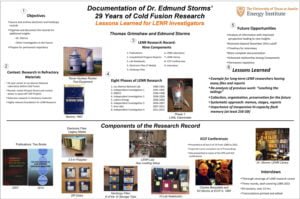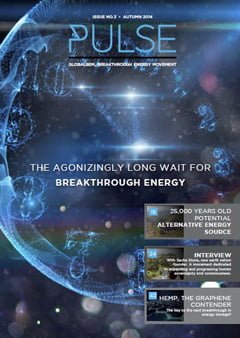Storms Book Review by Nikita Alexandrov
Book Review of The Explanation of Low Energy Nuclear Reaction by Nikita Alexandrov, President of Permanetix Corporation, was originally published in Infinite Energy Magazine issue #117 September/October 2014 and is reproduced here.
Dr. Edmund Storms, one of the foremost experts in cold fusion/LENR research has recently published a new book titled The Explanation of Low Energy Nuclear Reaction: An Examination of the Relationship Between Observation and Explanation. Dr. Storms worked at Los Alamos labs for 34 years studying energy related chemistry, specifically advanced nuclear projects. This book is currently the most up-to-date compilation of LENR research and contains over 900 references, but is written in such a way that it is organized and conducive to a well rounded understanding. According to the preface by Dr. Mike McKubre of Stanford Research Institute, “There is no better synthesis of knowledge and understanding presently available to us and I know of no other person capable of making an evaluation at this level.” While this could be considered a reference material for experimental results, it differs from Dr. Storms’ previous books in that it introduces his theory of the mechanism behind the LENR effect, an oscillating linear cluster of two or more hydrogen or deuterium atoms called the Hydroton.
The first half of the book contains a wealth of knowledge regarding the experimental results obtained in the field. This includes the physics of the various experimental systems as well as an overview of instrumentation and general trends in the collective data. There are a large amount of pictures and graphs which really help to mentally process some of the complex relationships in the data. This section of the book is critical for anyone interested in LENR because it organizes and condenses the experimental procedures and results in a way which makes the huge amount of seemingly contradictory research much simpler to understand. Dr. Storms takes a first-principles approach and imposes certain limits on the parameters of LENR theory based on what has been observed and basic chemical and physical principles. The experimental techniques used in the field are explained as well as the limitations and some reasons all of the facets of the LENR effect have eluded researchers. An overview of the physics of radiation from various nuclear reactions which may be present is very helpful in explaining the odd experimental results of the field. It is proposed that only a few types of radiation are produced directly from the LENR reaction but secondary radiation is produced from either the interaction of radiation with other matter in the system, traditional nuclear effects such as fractofusion (example: Ti-D experiments) or combination fusion-fission reactions (very unique part of the Hydroton theory). Dr. Storms goes into detail about how he believes various triggering methods initiate or improve the production of the LENR effect.
Dr. Storms’ theory revolves around a linear oscillating cluster of two or more hydrogen or deuterium atoms called a Hydroton. Under certain conditions this structure forms in the nano-cracks of metallic substrates. This differs significantly from the early theories of LENR in that it does not take place in the metallic lattice. Many theories are based on the fact that hydrogen or deuterium loaded into a metallic lattice inherently become pushed very close together, a shortcut towards fusion. These same theories require that the nuclear energy be communicated directly from the nucleus to the electrons (lattice) which is not unheard of but is not a traditional nuclear pathway and requires a complex explanation. Dr. Storms examines the lattice vs. nano-crack argument from a chemical, thermodynamic and transport standpoint, pulling from what we know of nuclear product production in LENR and the physics and chemistry of hydride/deuteride systems. Dr. Storms insists that it is simply not possible to both produce fusion and dissipate the energy inside of a lattice. His model does not rely on energy dissipation via the lattice but through a steady release of bursts of low energy photons as the Hydroton oscillates and fusion occurs. Another significant difference compared to most theories is that it explains the different results obtained using deuterium vs. using hydrogen via two different mechanisms. This is important because many early theories only focused on deuterium fusion ignoring hydrogen all together, but modern experiments show that hydrogen does indeed participate in the LENR effect. Lastly, Dr. Storms explains the various methods of producing transmutation products, either via a fusion-fission reaction of a hydrogen containing Hydroton or by the substrate atoms becoming part of the Hydroton in deuterium containing Hydrotons. The mechanism producing tritium and helium is explained in detail as well, but will not be explained here. Dr. Storms’ theory explains all known aspects of LENR in a very new way, not requiring the limitations of the mechanism taking place directly in the substrate lattice.
This theory is testable in various manners. Dr. Storms makes some suggestions in the book including the confirmation of predicted transmutation products as well as the detection of soft radiation such as low energy photons, betas, alphas and energetic ions. Dr. Storms points out that the reason radiation is not often detected is that the expected types and energies of radiation can simply not be detected outside of the experiment, requiring in-situ soft radiation detectors. So far it seems that experimental results line up with Dr. Storms’ theory but since his theory was built around this data it is important that future experiments be compared to what is expected using his model. Single or multiple deuterium addition to the substrate in deuterium containing Hydrotons, or fusion-fission products in hydrogen containing Hydrotons, would be expected and a good place to examine the theory experimentally.
Overall this is an excellent theory which can make some predictions; it will not allow us a complete mastery of LENR but is a large step in the right direction. Most of Dr. Storms’ theory is based on traditional physics and chemistry but there are certain aspects which are not fully understood, specifically how a Hydroton releases controlled bursts of photons at very low energies before the completion of the fusion process. This is the sticking point of LENR theory—it is not so hard to explain how two atoms fuse, but how they release their huge amount of energy without creating standard hot fusion products and detectable radiation as well as destroying the lattice local where the event took place.
By investigating experimental results and applying his physics and chemistry understanding, Dr. Storms is able to produce some basic equations which explain the power produced by LENR systems and show optimal operating conditions. Like everything else Dr. Storms produces, these equations are created using first principles and basic science; a Ph.D. is not required to wrap your head around this book as well as his theory in general.
Dr. Storms’ book contains a chapter of modern theories of LENR including limitations and possible shortcomings. This inventory of theories is great because it provides an excellent balanced overview of the field from a theoretical standpoint. This combined with the overview of the field from an experimental standpoint makes this the best reference book in the field of LENR. This book is highly recommended for anyone from the student interested in learning about LENR for the first time to highly trained scientists working in the field of LENR. There will be no disappointment in the level of detail and with over 900 references it provides an incredibly organized wealth of information regarding LENR experiments and theory.
The final chapter “Future of LENR” provides a road-map forward, listing the requirements for mastering the LENR effect as well as what needs to be done experimentally to get there. One thing the book does not mention is that Dr. Storms is ready and willing to put his LENR skill-set and understanding to the ultimate test—along with other researchers Dr. Storms has proposed an experimental research program to further the understanding of LENR. Dr. Storms is currently in the process of raising money for this research program and at millions of dollars per year, this could be the Manhattan project of LENR. The only thing standing between mankind and a guaranteed increased understanding of LENR is research funding and public awareness. I urge anyone interested in LENR to inform others about this book and the field in general and those which are financially independent to contact Dr. Storms about his research proposal.
Read the original article published on Infinite Energy.
Related Links
The Explanation of LENR Homepage https://lenrexplained.com/
Nikita Alexandrov Advanced analytic and highly parallel Cold Fusion Experimentation [.pdf] presented at the 2014 CF/LANR Colloquium at MIT.



